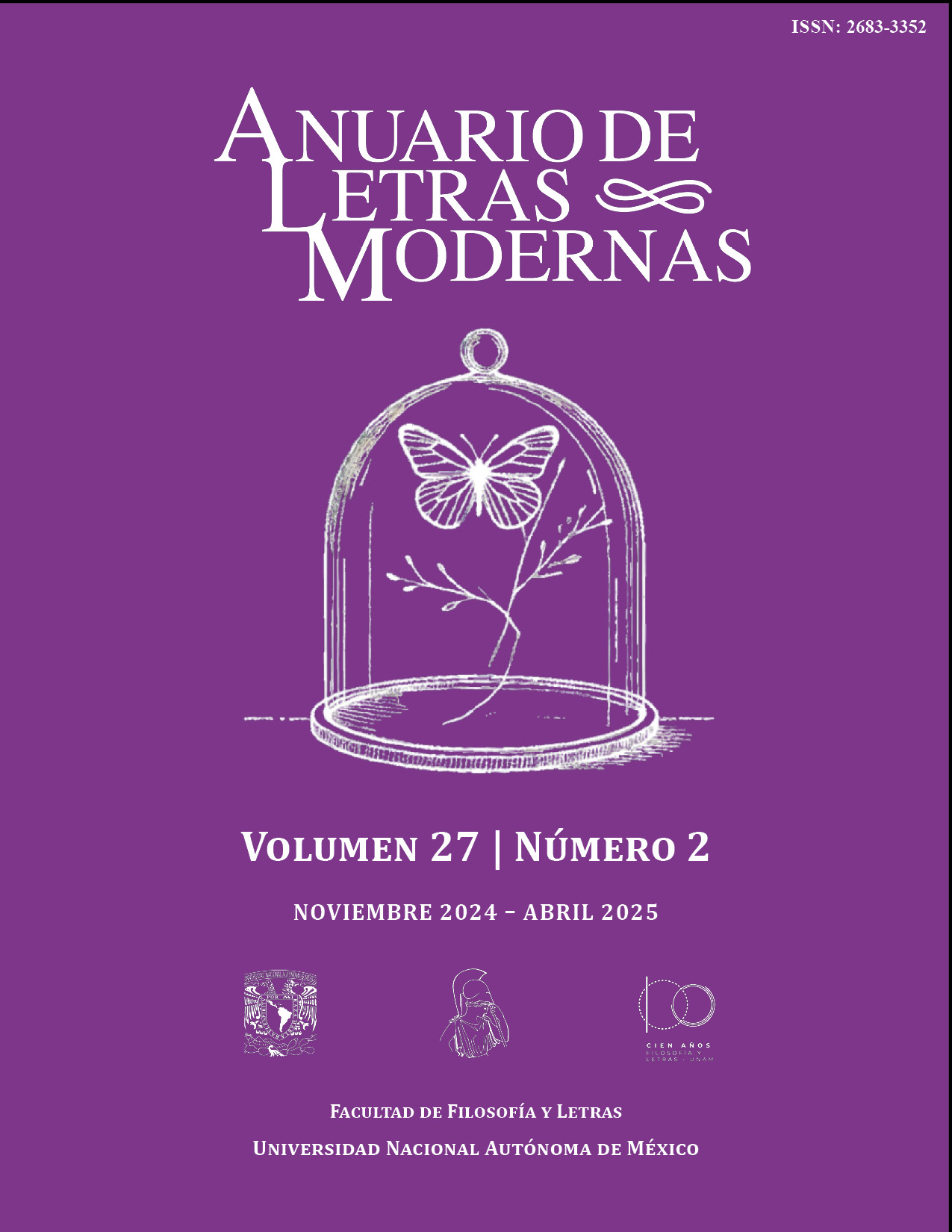“Take off my death again”: Fragmentation and the Becoming of Lady Lazarus in Sylvia Plath and Jennifer Rahim
Main Article Content
Abstract
Contemplating the idea of continuity through fragmentation allows us to question how connections between different pieces produced by two female authors from diverse contexts within the wide spectrum of English literature take shape, bringing to light the fallacy of a direct and linear conjunction, while proposing less direct but more enriching liaisons. Furthermore, the fragmented quality of this way of thinking frees figures that once might have been considered as a closed unit to introduce diversity in the form of multicultural discourses as part of an ongoing dialogue. Such is the case of Lady Lazarus, seen as a character-theme that allows a cross-cultural dialogue between “Lady Lazarus” (1965) by Sylvia Plath and “Lady Lazarus in the Sun” (2008) by Jennifer Rahim. In these texts, two versions of the same character gain opacity through a fragmentation that has been built in a constant state of becoming, which allows the figure to be introduced into new realities. Therefore, this article seeks to explore the way in which both poets undergo complex negotiations where identity is composed through their poetic voice, Lady Lazarus, and other voices and stories through a fragmented body which is in a constant state of becoming. In this exchange, fragmentation acquires the characteristics of a two-way street where the character-theme constructs itself, paradoxically, through fragmentation, while its presence deconstructs dissonant materialities that triggered the death/resurgence cycle that characterizes Lady Lazarus. In this sense, this article will address fragments in becoming as a complex process in the construction of a multiple and subversive identity found in poetry written by women.
Article Details

This work is licensed under a Creative Commons Attribution-NonCommercial-NoDerivatives 4.0 International License.
References
ANTOINE-DUNNE, Jean. (2006). “Haciendo la palabra: La poesía de Jennifer Rahim”. Contexto, 10(12), 133-150.
BASSNETT, Susan. (2005). Sylvia Plath: An Introduction to the Poetry. Palgrave Macmillan.
BERISTÁIN, Helena. (2018). Diccionario de retórica y poética (9a ed.). Editorial Porrúa.
BRICKEY, Russell. (2018) Gale Researcher Guide for: Postconfessional Poetry and the Evolution of the Lyric “I”. Gale Cengage Learning.
CURIEL PICHARDO, Ochy. (2014). Construyendo metodologías feministas desde el feminismo decolonial [Conferencia]. Jornadas de metodología de investigación feminista y su aplicación en el ámbito de los derechos humanos, la violencia y la paz, San Sebastían-Donostia, País Vasco.
DONIGER, Wendy. (2023, agosto 11). “Kali” (en línea). Encyclopedia Britannica, Ancient Religions & Mythology. https://www.britannica.com/topic/Kali.
GILL, Jo. (2008). The Cambridge Introduction to Sylvia Plath. Cambridge University Press. https://doi.org/10.1017/CBO9780511817007
GRANDINI, Cynthia. (2022). “Y sin embargo, se mueven: la flȃneuse como tema-personaje”. Nuevas Poligrafías: Revista de Teoría Literaria y Literatura Comparada, (6), 151-164. https://doi.org/10.22201/ffyl.nuevaspoligrafias.2022.6.1773
GUTIERREZ FONOLLOSA, Maria. (2017). “(Un)framing the Caribbean: Spaces and Female Identity”. (Tesis de maestría, Universitat de Barcelona, España). http://hdl.handle.net/2445/117503
HONSALIES-MUNIS, Svitlana. (2018). “Body Image in the Poetry by Anne Sexton, Sylvia Plath, Adrienne Rich”. Anglistics and Americanists, (15), 119-126. https://anglistika.dp.ua/index.php/AA/article/view/170/426
PIMENTEL, Luz Aurora. (1993). “Tematología y transtextualidad”. Nueva Revista de Filología Hispánica, 41(1), 215-229. https://doi.org/10.24201/nrfh.v41i1.931
PIMENTEL, Luz Aurora. (1996). “Los avatares de Salomé”. Anuario de Letras Modernas, 6, 37–67. https://doi.org/10.22201/ffyl.01860526p.1994.6.911
PLATH, Sylvia. (2001 [1965]). “Lady Lazarus”. En Ariel (pp. 8-11). Faber and Faber.
RAHIM, Jennifer. (2011 [2009]). “Lady Lazarus in the Sun” (María Josefa Gómez Álvarez y Gloria Riva Morales Trads.). En vísperas de los días sabáticos (pp. 46-55). Fondo Editorial Casa de las Américas.
ROBERTS, Nichole. (2006). “Reflexiones sobre una nación: un acercamiento a la cuestión de la identidad en la poesía trinitaria de Jennifer Rahim”. Contexto, 10(12), 77-92. http://www.saber.ula.ve/handle/123456789/18966
SCHETRUMPF, Tegan Jane. (2015). “Diminished but Never Dismissed: The Confessional Poetry of Sylvia Plath and Bruce Beaver”. Antipodes, 19(1), 117-127. https://www.jstor.org/stable/10.13110/antipodes.29.1.0117
WALCOTT, Derek. (1998). “The Muse of History”. En What the Twilight Says (pp. 36-64). Farrar, Straus and Giroux.
WAGNER-MARTIN, Linda W. (1989). Sylvia Plath (Ángela Pérez Trad.). Circe Ediciones.

